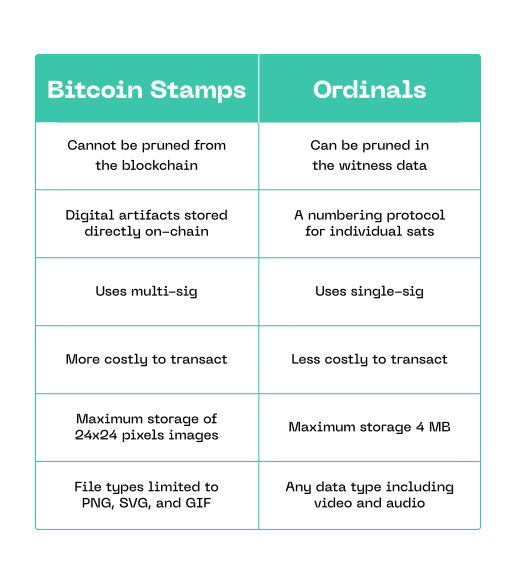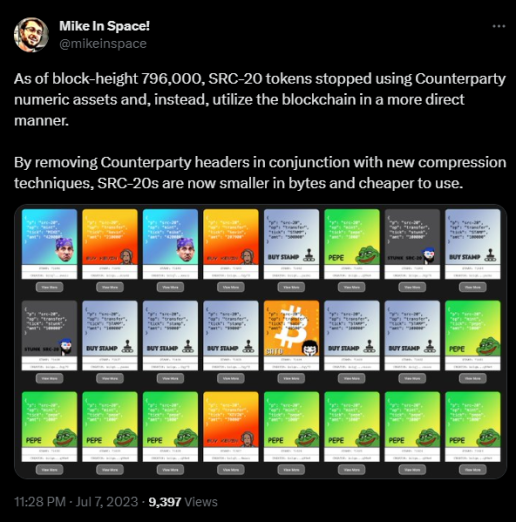2023 continues to be a big year for Bitcoin with new protocols and standards popping up everywhere. The wave of innovation nearly single-handedly brought back the bull market. But before we get ahead of ourselves, let’s try to understand what’s happening on the original blockchain — Bitcoin.
Ordinals started the excitement and it was followed by BRC-20 and BRC-721E. Throughout all of this, the SRC-20 token standard, also known as Stamps, was also cementing its place in the Bitcoin NFT scene and wider ecosystem.
Here’s what you need to know about the SRC-20 token standard.
What are Bitcoin Stamps and How Do Bitcoin Stamps Work?
Bitcoin Stamps (Bitcoin Secure Tradeable Art Maintained Securely) are digital collectibles stored directly on Bitcoin's blockchain. At their origin, they used the Counterparty protocol, which converts images into encoded files and broadcasts them to the Bitcoin network.
Bitcoin Stamps are different from other tokens because they’re stored in unspent transaction outputs (UTXOs) instead of witness data. These are records of unspent Bitcoin almost like the change you receive when you break a larger bill. If you hold one BTC and send someone half a bitcoin, the half bitcoin you have left is in the UXTO.
Minting Bitcoin Stamps has higher fees compared to other tokens, but their flexibility to mint larger quantities makes them popular. However, there are debates about the impact on blockchain size and transaction fees.
Bitcoin Stamps vs. Bitcoin Ordinals and Ordinal Inscriptions
Bitcoin Stamps and Bitcoin Ordinals have both made waves in the Bitcoin ecosystem recently. They each contribute something new and interesting to Bitcoin, but they’re different.
Bitcoin Stamps
Stamps are digital artifacts stored directly on the Bitcoin blockchain. Their purpose is to create and store things on the blockchain. Stamps cannot be pruned because they exist in the UTXO set, which are unsent transactions. However, Stamps can be destroyed when a wallet spends the UTXO set tied to it.
Bitcoin Ordinals
Ordinals track and number individual satoshis by assigning unique numbers to each one. Think of it like creating serial numbers for satoshis — this is called Ordinal theory. Unlike Stamps, Ordinals can be pruned by nodes removing old witness data.
Here’s an overview of the difference between Stamps and Ordinals:

Source: Trust Machines
What is SRC-20?
Bitcoin Stamps are also called SRC-20 tokens. The runaway train of Ordinals, the BRC-20 token standard, and the Counterparty protocol have spurred more innovation on Bitcoin and now, SRC-20 tokens on Bitcoin are at the forefront.
Mike In Space, the creator of Bitcoin Stamps, says that SRC-20 tokens are more secure and more immutable than Ordinals because they’re not prunable. “Prunable” means it’s possible to remove the data from the blockchain. Other Bitcoin standards store data on-chain in prunable witness data — meaning they’re liable to be removed.
SRC-20 Tokens and Requirements
Bitcoin Stamps must adhere to specific rules. For example:
- SRC-20 tokens can only encode JPG, GIF, PNG, or SVG files
- They can only be a maximum of 24×24 pixels
- A Bitcoin Stamp must be numerical with a unique identifier
- Stamps are created by adding the "stamp:base64" string in a new transaction
- Bitcoin Stamps cannot be duplicated on the same asset
These are the main characteristics of Stamps. You can read more details about how they work in a Github post by the founder Mike in Space.
SRC-20 Token Transaction Specifications and Decoding
When users mint or create Stamps, they encode a valid "STAMP:base64" string in the description key of a transaction.
Bitcoin Stamps can be decoded directly from the original Bitcoin transaction. To simplify and speed up the decoding process, Stamps started out using the Counterparty API to broadcast them to the blockchain. But as of block 796,000, Stamps encodes the SRC-20 transaction directly on the Bitcoin blockchain.

Source: Twitter
Once a Stamp is decoded, the images are uploaded to stampchain.io, where they can be accessed or traded. Users need The Stamp Wallet to mint, deploy, or transfer SRC-20 tokens on the marketplace.
How is SRC-20 Significant in the Bitcoin Ecosystem
As with many of the new developments on Bitcoin, there are plenty of skeptics. A lot of people still take issue with the idea of storing unnecessary data on the blockchain, congesting the network. SRC-20 tokens are no exception.
On the "What Bitcoin Did" podcast, Junseth suggested SRC-20 tokens are just ordinals with a different accounting system. However, Stamps founder Mike in Space tweeted that SRC-20 tokens are “persistently stored in the UTXO set,” making them truly immutable.
SRC-20 tokens are building more enthusiasm for NFTs on Bitcoin as new and better ways of securing data are emerging. One complaint NFT critics have voiced is the fact that, ultimately, most NFTs are stored on a centralized platform or database. SRC-20 tokens can remain directly on-chain forever. Some of the most popular tokens include:
- PEPE SRC
- KEVIN
- STAMP
- SATO
What Will Happen Next on Bitcoin?
It seems like nearly every month, something new is being innovated on the Bitcoin blockchain. Through the dull and constant hum of skepticism and downright criticism, a new song is being sung on the world's oldest blockchain.
The crypto industry is building even more meaningful and widely-used applications and protocols on Bitcoin in a way that skeptics didn't think possible. And as users continue enjoying the issuance and addition of new types of tokens on the Bitcoin blockchain, these new token standards also give life to the Bitcoin builders community, attracting builders from even beyond the BTC cryptocurrency community (including developers from newer blockchains like Ethereum).
In the end, the way people interact with SRC-20 tokens allows users to do even more with their BTC, and is convincing them that the potential for technologies built on top of Bitcoin is even bigger than they initially imaged.

